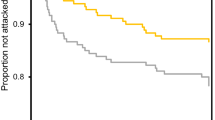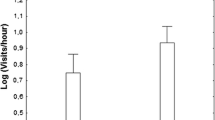Abstract
With the dramatic increase in research on Madagascar’s lemurs during the past few decades, it is now feasible to both document anti-predator behavior and to test predictions regarding the effect of predation pressure on the behavioral ecology of lemurs. In 1994 Goodman raised much interest by his suggestion that, in the absence of large, extant predators on Madagascar, anti-predator behaviors and strategies in lemurs were an artifact of a behavioral repertoire that existed before the extinction of a very large eagle, Stephanoaetus mahery. However, both before and subsequent to Goodman’s argument, numerous studies of both diurnal and nocturnal lemurs revealed that both extant avian and mammalian predators pose a real predation threat. (Sauther, 1989, 2002; Overdorff & Strait, 1995; Wright & Martin, 1995; Gould, 1996; Gould et al., 1997; Wright, 1998; Schwab, 1999; Karpanty & Grella, 2001; Karpanty 2003). In this chapter, we first present information on predation risk, group size, and foraging in the ring-tailed lemur (Lemur catta), and then we examine sex differences in predator vigilance, canopy level differences in vigilance, and how alpha females contribute to anti-predator strategies in this species.
Access this chapter
Tax calculation will be finalised at checkout
Purchases are for personal use only
Preview
Unable to display preview. Download preview PDF.
Similar content being viewed by others
References
Altmann, J. (1974). Observational study of behaviour: Sampling methods. Behaviour, 49: 227–265.
Baldellou, M., and Henzi, S.P. (1992). Vigilance, predator detection and the presence of supernumerary males in vervet monkey troops. Anim. Behav., 43: 451–461.
Budnitz, N., and Dainis, K. (1975). Lemur catta: Ecology and behavior. In I. Tattersall and R.W. Sussman (Eds.), Lemur biology (pp. 219–235). New York: Plenum.
Edgington, E.S. (1980). Randomization tests. New York: Marcel-Dekker, Inc.
Fedigan, L.M. (1990). Vertebrate predation in Cebus capucinus: Meat eating in a Neotropical monkey. Folia Primatol., 54: 196–205.
Goodman, S.M. (1994). The enigma of antipredator behavior in lemurs: Evidence of a large extinct eagle on Madagascar. Inter. Jour. Primatol., 15: 129–134.
Goodman, S.M, O’Connor, S., and Langrand, O. (1993). A review of predation on lemurs: Implications for the evolution of social behavior in small, nocturnal primates. In P.M. Kappeler and J.U. Ganzhorn, (Eds.), Lemur social systems and their ecological basis (pp. 51–66). New York: Plenum Press.
Goodman, S.M., and Langrand, O. (1996). A high mountain population population of the ringtailed lemur Lemur catta on the Andringitra Massif, Madagascar. Oryx, 30: 259–268.
Gould, L. (1994). Patterns of affiliative behavior in adult male ringtailed lemurs (Lemur catta) at the Beza-Mahafaly Reserve, Madagascar. Doctoral dissertation. Washington University, St. Louis, MO.
Gould, L. (1996). Vigilance behavior in naturally occurring ringtailed lemurs (Lemur catta) during birth and lactation season. Inter. Jour. Primatol., 17: 331–347.
Gould, L., Fedigan, L.M., and Rose, L.M. (1997). Why be vigilant? The case of the alpha animal. Inter. Jour. Primatol., 18: 401–414.
Hirsch, B.T. (2002) Social monitoring and vigilance behavior in brown capuchin monkeys (Cebus apella). Behav. Eco. Sociobiol., 52: 458–464.
Jolly, A. (1966). Lemur behavior. Chicago: Univ. of Chicago Press.
Jolly, A. (1984). The puzzle of female feeding priority. In M. Small (Ed.), Female primates: Studies by women primatologists (pp. 197–215). New York: Alan R. Liss.
Karpanty, S.M. (2003). Rates of predation by diurnal raptors on the lemur community of Ranomafana National Park, Madagascar. Amer. Jour. Phys. Anthropol. (Suppl. 36): 126–127.
Karpanty, S.M., and Grella R. (2001). Lemur responses to diurnal raptor calls in Ranomafana National Park, Madagascar. Folia Primatol., 72: 100–103.
Lewis, R.J. (2005). Sex differences in vigilance in Verreaux’s sifaka: Are males providing a predator detection service? Am. J. Phys. Anthropol. (Suppl. 40): 138.
Macedonia, J.M. (1990). What is communicated in the antipredator calls of lemurs: Evidence from playback experiments with ring-tailed and ruffed lemurs. Ethology, 86: 177–190.
Miller, L.E. (2002). The role of group size in predator sensitive foraging decisions for wedge-capped capuchin monkeys (Cebus olivaceus). In L.E. Miller (Ed.), Eat or be eaten: Predator sensitive foraging among primates (pp. 195–106). Cambridge: Cambridge Univ. Press.
Mittermeier, R.A., Tattersall, I., Konstant, W.R., Meyers, D.M., and Mast, R.B. (1994). Lemurs of Madagascar. Conservation International Tropical Field Guide Series. Washington, DC: Conservation International.
Overdorff, D.J. (1998). Are Eulemur species pair-bonded? Social organization and mating strategies in Eulemur fulvus rufus from 1988–1995 in southeast Madagascar. Amer. Jour. Phys. Anthropol., 105: 153–166.
Overdorff, D.J., and Strait, S.G. (1995). Life history and predation in Eulemur rubriventer in Madagascar. Amer. Jour. Phys. Anthropol., 100: 487–506.
Overdorff, D.J., Strait, S.G., and Seltzer, R.G. (2002). Species differences in feeding in Milne-Edwards’ sifakas (Propithecus diadema edwardsi), Rufus lemur (Eulemur fulvus rufus), and red-bellied lemurs (Eulemur rubriventer) in southeastern Madagascar: Implications for predator avoidance. In L.E. Miller (Ed.), Eat or be eaten: Predator sensitive foraging among primates (pp. 126–137). Cambridge: Cambridge Univ. Press.
Pereira, M.E., and McGlynn, C. (1997). Special relationships instead of female dominance for redfronted lemurs, Eulemur fulvus rufus. Amer. Jour. Phys. Anthropol., 43: 239–258.
Peres, C.A. (1993). Anti-predation benefits in a mixed-species group of Amazonian tamarins. Folia Primatol., 61: 61–76.
Rasolofoson, R.D.W. (2002). Stratégies anti-prédatrices d’Eulemur fulvus rufus (Audebert, 1800) dans la forět dense sèche de Kirindy, Morondava, Madagascar. Lemur News, 8: 29.
Ratsirarson, J. (1985). Contribution à l’Étude comparative de l’eco-ethologie de Lemur catta dans deux habitats différents de la Réserve Spéciale de Beza Mahafaly. Université de Antananarivo: Memoire de le fin d’etudes.
Rose, L.M. (1994). Benefits and costs of resident males to females in white-faced capuchins, Cebus capucinus. Am. J. Phys. Anthropol. 32: 235–248.
Rose, L.M., and Fedigan L.M. (1995). Vigilance in white-faced capuchins, Cebus capucinus, in Costa Rica. Anim. Behav., 49: 63–70.
de Ruiter, J.R. (1986). The influence of group size on predator scanning and foraging behaviour of wedge capped capuchin monkeys (Cebus olivaceus). Behaviour, 98: 240–258.
Sauther, M.L. (1989). Antipredator behavior in troops of free-ranging Lemur catta at Beza Mahafaly Special Reserve, Madagascar. Inter. Jour. Primatol., 10: 595–606.
Sauther, M.L. (1992). The effect of reproductive state, social rank and group size on resource use among free-ranging ringtailed lemurs (Lemur catta) of Madagascar. Doctoral dissertation. Washington University, St. Louis, MO.
Sauther, M.L. (1993). Resource competition in wild populations of ringtailed lemurs (Lemur catta): Implications for female dominance. In P.M. Kappeler and J.U. Ganzhorn (Eds.), Lemur social systems and their ecological basis (pp. 135–152). New York: Plenum Press.
Sauther, M.L. (1998). The interplay of phenology and reproduction in ringtailed lemurs: Implications for ringtailed lemur conservation Folia primatol., 69(Suppl. 1): 309–320.
Sauther, M.L. (2002). Group size effects on predation sensitive foraging in wild ring-tailed lemurs (Lemur catta). In L.E. Miller (Ed.), Eat or be eaten: Predator sensitive foraging among primates (pp. 107–125). Cambridge: Cambridge Univ. Press.
Schwab, D. (1999). Predation on Eulemur fulvus by Accipiter henstii (Henst’s goshawk). Lemur News, 4: 34.
Smith, A.C., Kelez, S., and Buchanan-Smith, H. (2004). Factors affecting vigilance within wild mixed-species troops of saddleback (Saguinus fuscicollis) and moustached tamarins (S. mystax). Behav. Ecol. Sociobiol., 56: 18–25.
Sussman, R.W. (1972). An ecological study of two Madagascan primates: Lemur fulvus rufus Audebert and Lemur catta Linnaeus. Doctoral dissertation. Duke University, North Carolina.
Sussman, R.W. (1974). Ecological distinctions between two species of Lemur. In R.D. Martin, D.A. Doyle, and C. Walker (Eds.), Prosimian biology (pp. 75–108). London: Duckworth.
Sussman, R.W. (1977). Socialization, social structure and ecology of two sympatric species of lemur. In S. Chevalier-Skolnikoff and F.E. Poirier (Eds.), Primate bio-social development: Biological, social, and ecological determinants (pp. 515–528). New York: Garland Publishing, Inc.
Sussman, R.W. (1991). Demography and social organization of free-ranging Lemur catta in the Beza Mahafaly Reserve, Madagascar. Amer. Jour. Phys. Anthropol., 84: 43–58.
Tattersall, I. (1982). The primates of Madagascar. New York: Columbia Univ. Press.
Taylor, L.L. (1986). Kinship, dominance, and social organization in a semi-free ranging group of ringtailed lemurs (Lemur catta). Doctoral dissertation, Washington University, St. Louis, MO
Treves, A. (2002). Predicting predation risks for foraging arboreal monkeys. In L.E. Miller (Ed.), Eat or be eaten: Predator sensitive foraging among primates (pp. 222–241). Cambridge: Cambridge Univ. Press.
Wright, P.C. (1998). Impact of predation risk on the behaviour of Propithecus diadema edwardsi in Ranomafana National Park, Madagascar. Inter. Jour. Primatol., 16: 835–854.
Wright, P.C., and Martin, L.B. (1995). Predation, pollination and torpor in two nocturnal prosimians: Cheirogaleus major and Microcebus rufus in the rain forest of Madagascar. In L. Alterman, G.A. Doyle, and M.K. Izard (Eds.), Creatures of the dark: The nocturnal prosimians (pp. 45–60). New York: Plenum Press.
Author information
Authors and Affiliations
Editor information
Editors and Affiliations
Rights and permissions
Copyright information
© 2007 Springer Science+Business Media, LLC
About this chapter
Cite this chapter
Gould, L., Sauther, M.L. (2007). Anti-Predator Strategies in a Diurnal Prosimian, the Ring-Tailed Lemur (Lemur catta), at the Beza Mahafaly Special Reserve, Madagascar. In: Gursky, S.L., Nekaris, K.A.I. (eds) Primate Anti-Predator Strategies. Developments in Primatology: Progress and Prospects. Springer, Boston, MA. https://doi.org/10.1007/978-0-387-34810-0_13
Download citation
DOI: https://doi.org/10.1007/978-0-387-34810-0_13
Publisher Name: Springer, Boston, MA
Print ISBN: 978-0-387-34807-0
Online ISBN: 978-0-387-34810-0
eBook Packages: Biomedical and Life SciencesBiomedical and Life Sciences (R0)




